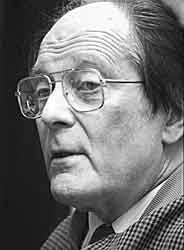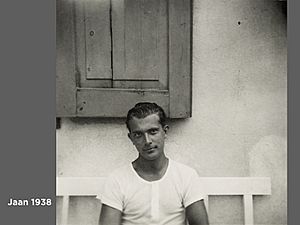Jaan Kross facts for kids
Quick facts for kids
Jaan Kross
|
|
|---|---|

Jaan Kross in 1987, by Guenter Prust
|
|
| Born | 19 February 1920 Tallinn, Estonia |
| Died | 27 December 2007 (aged 87) |
| Nationality | Estonian |
| Alma mater | University of Tartu |
| Genre | novels |
| Spouse | Helga Pedusaar Helga Roos Ellen Niit |
| Children | 4, including Kristiina Ross and Eerik-Niiles Kross |
Jaan Kross (born February 19, 1920 – died December 27, 2007) was a famous Estonian writer. He was known for his historical novels. In 1995, he won the International Nonino Prize in Italy.
Contents
Early Life and Challenges
Jaan Kross was born in Tallinn, Estonia. His father was a skilled metal-worker. Jaan studied at Jakob Westholm Gymnasium and later at the University of Tartu. He studied law there from 1938 to 1945. He also taught at the university for a short time.
When Kross was 20, in 1940, the Soviet Union took over Estonia. A year later, in 1941, Nazi Germany invaded and took control.
In 1944, during the German occupation, Kross was arrested for six months. He was suspected of being a "nationalist," meaning he supported Estonia's independence. After the Soviet Union took control again in 1946, he was arrested once more. He was held in prison in Tallinn. Then, in 1947, he was sent to a labor camp in Vorkuta, Russia.
He spent eight years in northern Russia. Six of those years were spent working in mines at a labor camp. For two more years, he lived as a deportee, but not in the camp. When he returned to Estonia in 1954, he became a full-time writer. His law degree was no longer useful under Soviet law.
At first, Kross wrote poetry. He often used historical figures to talk about current events. Soon, he started writing prose, which became his main type of writing.
Career as a Writer
Becoming Well-Known
Jaan Kross became the most translated and famous Estonian writer. He was nominated many times for the Nobel Prize in Literature in the early 1990s. He received important awards, including the title of People's Writer of the Estonian SSR in 1985. He also got the State Prize of the Estonian SSR in 1977.
Kross received many honorary degrees and international honors. These included Estonia's highest order and one of Germany's highest. In 1999, he won the Baltic Assembly Prize for Literature, the Arts and Science. He also won the Amnesty International Golden Flame Prize in 1990.
Because of his importance, Kross's books were translated into many languages. These included Finnish, Swedish, Russian, German, and Latvian. By 2015, five of his books were published in English in the United States and UK. Some shorter stories were also translated into English during Soviet times.
Most translations were done directly from Estonian. Sometimes, during Soviet times, they were first translated into Russian, then into English. Today, Kross's works are translated into English from Estonian or Finnish.
Kross learned German when he was young. His family friends spoke it, and his mother knew it well. He learned Russian mainly while he was in the labor camp. He also knew some Swedish. He translated works from French, German, Russian, and English. These included famous books like Alice in Wonderland, Macbeth, and Othello.
Writing Style and Topics
Kross's novels and short stories are almost always historical. He is known for making historical novels popular again. Most of his stories take place in Estonia. They often explore the relationships between Estonians, Baltic Germans, and Russians.
Often, Kross's stories about Estonians fighting against Baltic Germans were a way to talk about the struggle against Soviet rule. But his books are popular worldwide because they also discuss bigger ideas. These include mixed identities, loyalty, and belonging.
Many people consider The Czar's Madman to be Kross's best novel. It is also his most translated book. Professor Martens' Departure is also well-known. It is popular with academics because it deals with topics like expertise and national loyalty.
Kross's historical novels can be divided into two types. Some are truly historical, set in past centuries. Others are more modern stories with parts of his own life in them.
A key part of Kross's writing style is the "internal monologue." This is when a character thinks through a difficult problem in their mind. You will notice this in many of his main characters.
Another common feature is comparing different historical times to the present. For much of Kross's life, "the present" meant Soviet rule. This included censorship and limited freedom. Kross was very skilled at writing in a way that the Soviet authorities would accept. He also liked to play with characters who had similar names.
In his later years, Kross gave lectures at Tartu University. He explained how some of his characters were based on real people. These lectures were put into a book called Omaeluloolisus ja alltekst (Autobiographism and Subtext) in 2003.
In his last twenty years, Jaan Kross wrote his memoirs. These were called Kallid kaasteelised (Dear Co-Travellers). The two volumes were 1,200 pages long and included many photos. He wrote about his childhood and school days. He also described the first Soviet occupation of Estonia. He shared how he avoided being forced into the Waffen-SS during the Nazi German occupation. A large part covered his time in prison and labor camps. The last part described his return and becoming a writer. The second volume continued with his success as a writer. It also covered his time as a Member of Parliament after Estonia became independent again.
Book Summaries
Books Translated into English
Five of Jaan Kross's books have been translated into English. These include four novels and one collection of stories. The English translations are: The Czar's Madman (1992), Professor Martens' Departure (1994), The Conspiracy and Other Stories (1995), Treading Air (2003), and Sailing Against the Wind (2012). The main characters in the first three books are based on real people.
The Czar's Madman (Estonian: Keisri hull, 1978; English: 1994; translator: Anselm Hollo). This sad novel is about Timotheus von Bock (1787–1836). He was a nobleman from the Baltic-German region. He worked for the Russian Czar, Alexander I. Von Bock wanted the Czar to free the serfs, who were like slaves. But this idea was too much for the Czar. In 1818, von Bock was arrested and kept in prison. He was released by the next Czar. But by then, he had mental problems and spent his last years under house arrest. Many people think this is one of Kross's best novels.
Professor Martens' Departure (Estonian: Professor Martensi ärasõit, 1984; English: 1994; translator: Anselm Hollo). In June 1909, an Estonian professor named Friedrich Fromhold Martens (1845–1909) takes a train to Saint Petersburg. He works for the Russian Empire's Foreign Ministry. During his trip, he thinks about his life. He wonders if he should have focused on his Estonian identity instead of his career in the Russian government. He also thinks about another legal expert with a similar name. This novel looks at the compromises people make when building a career in a large empire.
Sailing Against the Wind (Estonian: Vastutuulelaev, 1987; English: 2012; translator: Eric Dickens). This novel is about Bernhard Schmidt (1879–1935), an Estonian from Naissaar island. He loses his right hand in a firework accident as a teenager. But he uses his other hand to become amazing at polishing lenses and mirrors for telescopes. Later, living in Nazi Germany, he invents large telescopes. Some of these are still used today, like at the Mount Palomar Observatory in California. Schmidt struggles with his conscience. He worries that his telescopes could be used for military purposes by Germany. But he feels comfortable there because Germany was a leader in technology. The rise of the Nazis, however, starts to drive him mad.
The Conspiracy and Other Stories (Estonian: Silmade avamise päev, 1988; English: 1995; translator: Eric Dickens). This book has six stories. Most of them are partly about Jaan Kross's own life. They cover his experiences during the German and Soviet occupations of Estonia. They also describe his time in prison during those years. The stories include The Wound, Lead Piping, The Stahl Grammar, The Conspiracy, The Ashtray, and The Day Eyes Were Opened. All of them have a mix of sad and funny moments.
Treading Air (Estonian: Paigallend, 1998; English: 2003; translator: Eric Dickens). The main character in this novel is Ullo Paerand, a talented young man. He goes to a fancy private school. But his father, who was a speculator, leaves him and his mother. They run out of money. Ullo helps his mother with a laundry business to make ends meet. He works his way up and becomes a messenger for the Estonian Prime Minister's office. He even gets a chance to leave Estonia and study at the Vatican, but he chooses to stay. This novel, partly based on Kross's life, is set during a very difficult time in Estonia's history. It covers the Soviet occupation in 1940, the German occupation in 1941, and the bombing of Tallinn in 1944. It then continues for thirty more years of life in Soviet Estonia.
Between Three Plagues (Kolme katku vahel, four volumes 1970–1980; English: three volumes 2016–2018; translator: Merike Lepasaar Beecher) This was Kross's first big work and his longest. It started as a film script, then became a TV show, and finally a four-volume series of novels. It is one of Kross's most famous works. The story takes place in the 16th century, during the Livonian War (1550s to 1580s). Livonia included parts of what are now Estonia and Latvia. At that time, it was divided and ruled by Denmark, Sweden, Russia, and Poland-Lithuania. The main character is a real person, Balthasar Russow (c 1536–1600). He wrote the Livonian Chronicle, which describes the politics and wars of the time. Estonians, who were mostly peasants, often suffered during these conflicts. There were also three outbreaks of the bubonic plague. Russow was the son of a peasant but became a German-speaking clergyman, which was a big step up in society. The story begins with young Balthasar watching tightrope walkers in Tallinn. This is a symbol for his own difficult diplomatic balancing act later in life.
Death
Jaan Kross passed away in Tallinn on December 27, 2007, at the age of 87. He was survived by his wife, children's author and poet Ellen Niit, and their four children. The President of Estonia at the time, Toomas Hendrik Ilves, praised Kross. He called him "a preserver of the Estonian language and culture."
Kross is buried at the Rahumäe cemetery in Tallinn.
Quotes
- "He was one of those who kept fresh the spirits of the people and made us ready to take the opportunity of restoring Estonia's independence." — Toomas Hendrik Ilves
Tribute
On February 19, 2020, Google honored Jaan Kross on his 100th birthday with a special Google Doodle.
Images for kids
See also
 In Spanish: Jaan Kross para niños
In Spanish: Jaan Kross para niños




